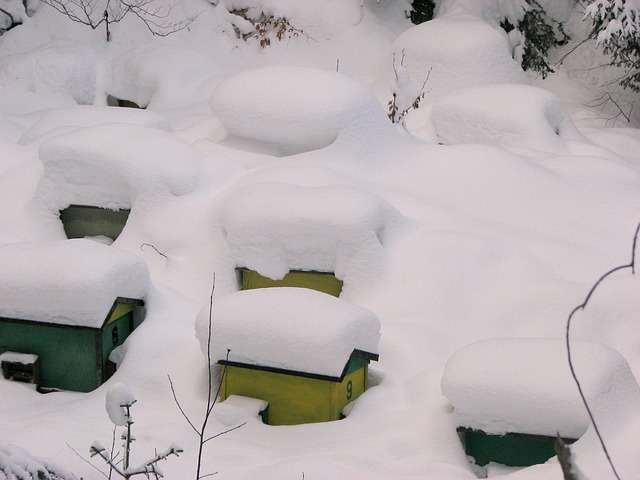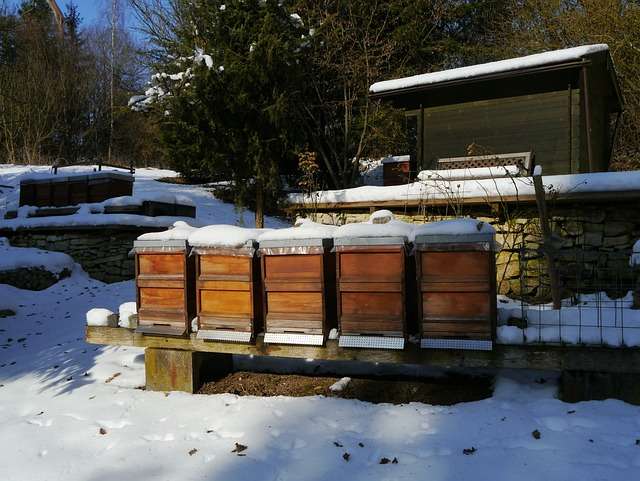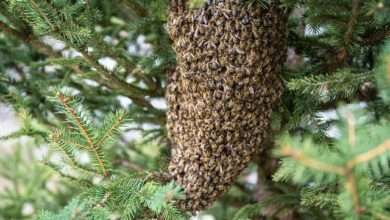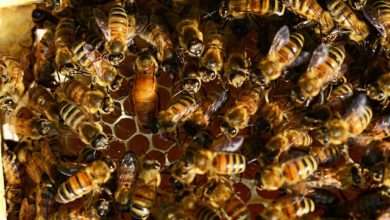What Are Your Bees Doing During Winter?

It’s easy to lose sight of the demands of your honey-producing bees in the wintertime, among all the other chores around the farm. Not so fast, however. Additionally, they need your assistance.
To get your hives ready for the winter, you need to know how your climate affects bees and what happens to them throughout the colder months.
When Winter Comes, What Happens to the Bees?
People often ponder, “What do bees do in the winter?” when autumn approaches and blossoms wither.
Bees don’t do anything other insects do to survive the winter, such as hibernating or laying eggs that will hatch in the spring. The bees continue to work throughout the winter.
To that end, what fate befalls bees when winter sets in? The bees’ only focus from fall through spring is keeping the queen alive and well enough to mate next year. They are willing to sacrifice their lives if it means accomplishing their mission.
The bees will gather around the queen once the temperature reaches 55 degrees. Similarly, the tighter the temperature, the more compact the cluster. The workers will shiver and flap their wings to maintain a hive temperature of about 96 degrees. They take turns outside so that no one gets too cold or tired of the constant motion.
Shivering and flapping wings to maintain a comfortable temperature in the hive requires much work. For energy, the bees will consume honey as they fly around the hive, producing a warm environment.
The bees will remain in the hive for the cold season, consuming honey to keep themselves warm. But if the temperature outside rises beyond 40 degrees, some bees may depart the hive to reduce the garbage they produce. All of the hives at a bee farm need nourishment, hydration, and warmth over the winter.
Beekeeping in the Cold Season

No matter how mild the winters are, you should still leave honey for the bees to use throughout the cold season. Honey is the greatest food for bees in the winter, but there are other options.
A beehive will need roughly 30 pounds of honey to get it through the winter, give or take. As a result, when winter comes, most beekeepers who employ Langstroth hives leave behind one medium or deep box for the bees to use.
In the event of a very long winter, some beekeepers choose to add an extra box, known as a super. This has the potential to benefit the hive, but it also makes the interior larger, which the bees will need to heat and protect.
The bees are fed well without taking up unnecessary room if you learn how to create fondant. Bee fondant is simple and may be made in the summer and stored in the freezer for later use when winterizing the hives.
Note of caution: don’t attempt to substitute fondant or syrup for honey if you want to leave any for the bees. To be clear, fondant is not a replacement for the bees’ regular diet; rather, it serves as a supplement.
To keep the cluster together while they forage throughout the hive, you should remove the queen excluder between the deep boxes. To collect honey for the queen and the rest of the bees, worker bees will have to leave the cluster and go to the top box if the queen needs to remain in the bottom. This is a dangerous use of the hive’s resources.
Water is supplied within the hive throughout the winter. Condensation will form due to the high humidity within the hive, which the bees may then drink. However, ensuring ventilation in the hive is essential since too much condensation might be dangerous. Condensation is expected on the box sidewalls but not on the bees themselves.
Checking on the bees while the temperature is below 40 degrees is dangerous. The warm air in the hive is lost every time it is opened, and the cold air is let in.
However, there is a technique to tell whether the bees are still alive even though most beekeepers don’t go into their hives throughout the winter. If you tap on it, you can hear the bees buzzing within the hive. You don’t have to do this every day or week, but you should check in on it again.
The end of the winter, when it starts to warm up and the bees start to leave the hive to feed, is the most difficult period of the year for bees. Most of the time, the bees return empty-handed and hungry since there needs to be more pollen or nectar for them to survive. Depending on how much honey the bees have consumed thus far, there may or may not be left in the hive. As of right now,
The bees will only stand a chance with sugary treats or sweet syrup. For a beekeeper, this is the most crucial period to make frequent visits to the hives.
Protecting and Keeping Bees Warm
Bees generally do a fantastic job maintaining a consistent temperature in the hive. But if you live in a very cold or very hot area, you may need to assist them in keeping warm by installing insulation or windbreaks.
Since snow is an excellent insulator, it is optional to clear it from the top of the hives. However, the hive’s entrance must be free of snow so the bees may come and leave as they like. The aperture provides additional ventilation, thus reducing the likelihood of moisture building up within the hive.
To keep their hives warm, some beekeepers may wrap them in batting or foam and then cover that with tar paper. Some people may use hay bales to insulate their hives, but only on three sides, leaving the front exposed. Keep in mind that regardless of the kind of insulation you choose, ventilation will be essential to the survival of the hive’s inhabitants.
You may also use windbreaks to maintain the heat in your hives, but you need to be cautious about arranging them in a way that does not prevent access to the hive entrance. Fences or stacks of hay bales are used to construct windbreaks. If you want to use hay bales as insulation or as a windbreak in winter, you should be aware of the possibility of encountering rats.
If you have a permanent windbreak, such as a fence, and need to transfer your hives, you should do it in the dark and only move them a few feet at a time. This will help prevent the bees from becoming disoriented. It would be best if you started this operation as soon as possible during the season.
Rodents, cockroaches, and even ants have been known to take refuge in a hive during winter. This occurs in both very cold and extremely warm environments. Raising your hives off the ground and using traps for mice and rats are good strategies.
Winterizing Your Colonies for Your Local Climate
I usually advise new beekeepers to find an experienced beekeeper who has managed bees through multiple winters in their location to learn from and get advice on how to winterize their hives for their climate properly. Having a local beekeeper to discuss how the weather in your area affects the bees over the winter is the single most useful thing you can do for your hives.
Regardless of the weather, bees have the same fundamental requirements: they must have access to food, water, ventilation, heat, and protection from harmful organisms. Before you can figure out how to offer these needs for your beehives, you will first need to educate yourself about the climate in your region.
FAQ

When winter sets in, what happens to bees?
In the cold winter, honeybees must cluster close together to be warm (and alive). They need access to comforters, fireplaces, or programmable thermostats. When the temperature outside drops below 50 degrees Fahrenheit (10 degrees Celsius), honeybees do something like a gigantic three-month slumber party: they withdraw within their hives and form a winter cluster to stay warm.
Can bees survive the winter?
It’s not true that bees hibernate throughout the winter like mammals. Instead of becoming dormant to save power, they continue to operate normally. Instead, the colony uses its flying muscles as a little heater during the cold season. This is why there is usually little action at the hive entrance during the colder months.
Can you imagine a situation where bees would actively fly throughout the winter?
Bees don’t hibernate or migrate south for the winter as birds do. So, tell me, bees, what do you do during the cold months? What they’re doing is trying to stay alive. All their efforts go toward staying alive until spring, which they hope will bring warmer weather.
In what range of temperatures do bees stop working?
The answer is conditional on the weather. Generally speaking, bees will go out when it is warm enough to collect nectar and then head back inside when the temperature drops. Why? Because when the temperature drops below 50 to 55 degrees Fahrenheit, bees get lethargic and start to sleep.
When winter comes, how can you tell whether bees are still active?
However, there is a technique to tell whether the bees are still alive even though most beekeepers don’t go into their hives throughout the winter. If you tap on it, you can hear the bees buzzing within the hive. You don’t have to do this every day or week, but you should check in on it again.
What about feeding bees over the winter?
Now is the best time to feed your bees a special winter diet. The honey bee does not hibernate throughout the winter but relies on stored food to keep it warm. Whenever the internal temperature of the hive drops below fifty degrees
Do bees need hydration in winter?
It’s important to provide water for bees, so late-winter watering holes will help keep them away from your Pool Garden in summer. Like all other creatures, Bees need sustenance, water, and a safe place to nest.
Is there anything we can do to aid bees during winter?
It would be best if you waited until spring to remove the annuals and perennials that have died. They’ll collect falling leaves and use them to make mulch while protecting against pest damage during winter. Many wild bees, including bumblebees, overwinter in little nests on bare soil, so it’s important to leave them alone.
Do wintertime bee colonies need sugar water?
Do not give honey bees sugar water when they are huddled together. Under 50 degrees Fahrenheit, bees won’t eat a liquid sugar material. During the colder months, they seek sweeter foods like honey and candy boards.




